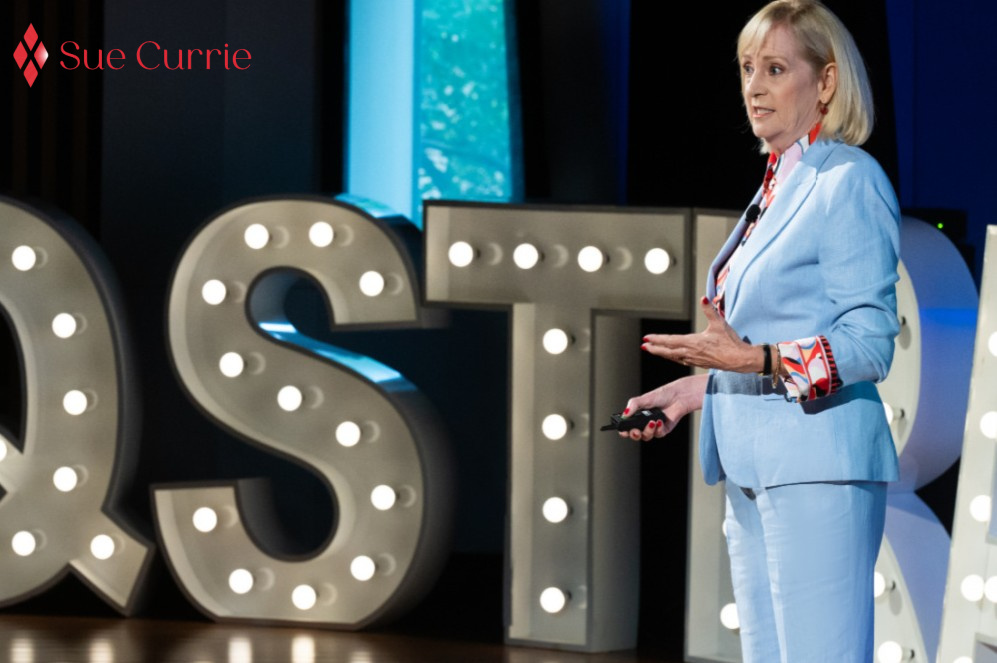As I await viewing the footage of a recent keynote I presented, I’m sharing a few tips of what I teach in my presentation skills training, with the first being to evaluate your performance.
This element is generally the final part of training as once you’ve understood crafting of content, use of structure, technique and practised delivery, it is important to review your overall skill including engagement of the audience.
Often, we put off evaluating our presentation because the lead up to it was nerve racking and uncomfortable. To be confident in the spotlight as a speaker, it is important to remember that no matter how much you want to forget about it, if you want to learn and be better next time then you must review the presentation you’ve just given.
S – set up, and structure
The first stage in planning your presentation should be to find out as much about your audience as possible. Who are they? Research the culture of organisation. Ask, what are the interests of the audience? What are their roles, ages, genders and educational backgrounds?
What is in it for the audience? What’s the “take-away” for them?
Find out how they will benefit from your presentation and if there is anything topical or controversial. What other presentation logistics do you need to be mindful of?
There are three main ideas to think about when structuring a presentation:
1. Have a beginning, a middle and an end. Leading into your speech with a strong and compelling statement, statistic or anecdote on what you are talking about will spark interest and attention from you audience.
2. Don’t try and put too much in (less is more) If you take too long to get to the point whether it’s a speech, answer to a question or putting forward a business proposal, you risk losing the listeners’ attention. Say it simply.
3. Reinforcement is always a good idea. Remind your audience of the key points and have a call to action.
H – hands and gestures
Stillness has more power – therefore if delivering something important stand in one spot. Keep movement natural. It’s okay to walk and use hand gestures but be aware not to pace back and forth and move unnecessarily.
Observe body language. The best way is to video record yourself and watch back without sound to see any unnecessary gestures like hands in pocket, flicking hair around, hands on hips etc.
Eye Contact. The right amount takes practise. 4-5 seconds of delivering one point then moving on. In large rooms look at various spots, front, back middle. Don’t just look at the smiler or nodder – try to make eye contact with all or most of the people there.
I – interaction and props
In most presentations, facts play a large part, however the support you use can make it easier for your audience to understand and appreciate the facts more easily. Many presenters will rely on a slide presentation but do consider other types of support including statistics; testimonials and quotes; specific case studies; handouts and/or flip chart.
Variety is what is required and can be built into your presentation through humour, use of props, audio-visuals, group exercises, audience involvement and storytelling. Try a range of techniques to keep your audience energised and interested.
Know the room and layout beforehand and if possible, rehearse in the room or walk around and on stage beforehand. Know the equipment you are working with such as laptop, slides, AV, mic, handouts and other props.
N – noise, sound and stories
The strong and effective use of your voice is one of the most powerful presentation tools you can possess. The worst thing you can do in a presentation is to be boring! To improve vocal delivery, you can:
o Warm up your voice
o Practise difficult phrases and articulate
o Vary your pace – faster, slower, pausing – for emphasis, drawing attention, recollecting thoughts
o Volume – softer, lighter, louder, stronger – to add variety
o Emphasis – accents on certain words, boom, pop, strong – ideally use a combination of all these points
o Liven up with improvisation and creativity
Storytelling is very compelling, but it does take practise. Review a previous blog on the Steps to Storytelling.
When I mention sound, it could be the use of music in your presentation or perhaps including a video – which bring me to my next tip…
E – experience and energy
You are unique, no one can deliver a talk or presentation in your style. You are you and that is your advantage.
Create a positive experience for yourself with plenty of preparation, allow time for rehearsal, inject your personality and stories and energy into your presentation. This will help to inspire your audience with passion and enthusiasm for your topic.
Have a clear outcome in mind of what you want the audience to take away from your presentation. Remember it’s about them and how you make them feel. It could simply be that they feel comfortable with you to provide a particular service, or you’ve convinced them your product is the best on the market. It could be to motivate them to do something or inspire or challenge them to try something new.
And finally, to reinforce my first point – remember to evaluate.
Even if you feel you have not given a great keynote, it is important to remember that no matter how much you want to forget the presentation, if you want to learn and be better next time then you must review the presentation you’ve just given by looking at both the strengths and at areas in which you see an opportunity to improve.
Although budding presenters may shy away from learning presentation skills due to nerves and lack of confidence, as quoted by Ralph Waldo Emerson, "All the great speakers were bad speakers at first."
Read more about being in the spotlight, in The Secret to Your Personal Brand Revolution. Get Your Free eBook Now!
Sue Currie is an image entrepreneur who guides and empowers business leaders and entrepreneurs to have “Spotlight Confidence”. She is passionate about helping professionals elevate their personal and professional brand through her speaking, coaching and training programs on Self Brand, Style and Speaking Skills, providing a multi-faceted approach to gain high transformation for her clients.





